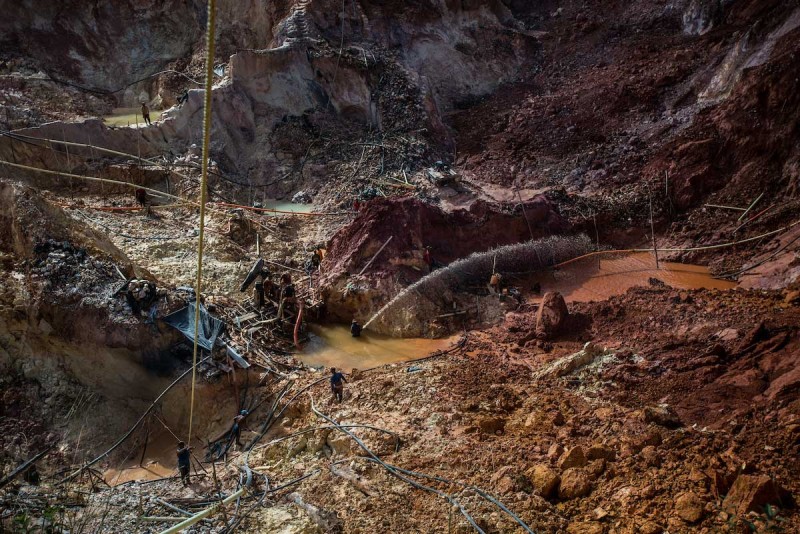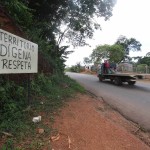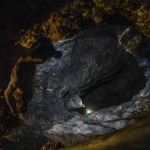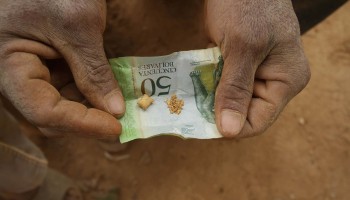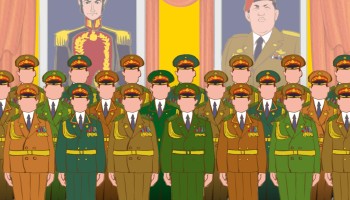The rise of organized crime in Venezuela’s Southern Bolívar region has been directly proportional to the state’s neglect of local people and towns. Criminal gang lords impose terror using the same methods of extreme violence favored by the leaders of Venezuelan prisons, the pranes, turning the mining business into part of their criminal network.
The teeth of Humberto Martes are capped with gold. Seven thick gold chains hang around his neck. Each bears a medal — six with his initials and one showing a relief of Christ’s face. There’s a gold watch on his left wrist and a heavy gold bracelet on his right.
Similar jewelry festoons an 11-month-old toddler, the youngest of his 25 children (according to his cousin Yolmaira and his mother Francisca).
Martes is about 50, tan, gray-haired and wide-bellied. Just 5’3” tall, he carries a gun strapped to his waist. And here in the gold mining town of Las Claritas, deep in Venezuela’s Orinoco Mining Arc, he’s an important man.
All kinds of people queue outside Martes’ house and ask for his help. In fact, the place is known as “Humberto’s office.”
An old man leaning on a stick wants help for a relative with a fractured hip. Isabel García asks permission to install a power outlet for her sewing machine. Edmundo Bautista travelled 400 miles to ask for a job. By noon, he’s been hired to help build a house. Two youths request Martes’ intervention because, they say, a group of drunks destroyed a motorcycle and fled. They hope he can solve the problem “by hook or by crook.”
Martes is proud of his role in the community, seeing himself as a benefactor. “I treat everyone well and I help them when I can,” he says. For example, he makes fish soup every Thursday and offers it to his visitors.
But he has other duties as well, which point to a darker role. Among other things, Martes is charged with collecting dues in gold (gramas, the miners call them) that each gold buyer must pay in exchange for protection if he wants to stay in business. Other vendors and shop owners in Las Claritas must pay in cash.
“Everyone’s got to contribute here so we can keep order. I never rest, as you can see,” Martes says, adding that he starts watching and collecting at 5 a.m. each day. When he leaves his residence, it’s aboard a Toyota Fortuner. He also has a Toyota 4Runner and a king-cab Toyota Hilux. Few in Las Claritas can boast such luxuries.
When he gets home from his rounds, Humberto pulls small packets of gold from his pockets and transfers them to a transparent plastic bag, in full view of everyone, including the Bolívar state policemen who sometimes drive by his “office” but seldom bother to look.
Everything’s recorded by his own security cameras.
Martes is a senior leader in the local pranato — a criminal mob that holds an iron grip over ten million ounces of gold and a billion and a half pounds of copper — the estimated amount contained in just part of the Las Brisas-Las Cristinas mines, the largest in Venezuela.
In Venezuela’s prisons, the pran (gang boss), who gives pranato its name, is the supreme and unquestionable leader of the criminal structure. He manages all illegal trade, including arms and drug trafficking, and has an entourage at his disposal. He freely makes use of the assets and lives of the inmates he oppresses. Defying him means almost certain death. The pranato in Las Claritas is structured much the same as its prison counterparts, imposing its will through fear and lead.
The Venezuelan Observatory of Violence, an academic organization which studies the roots and impact of violence on society, says that pranato arise when law breaks down. It’s survival of the fittest: “The [pranato] is a symbol of the breakdown of formal institutional control, in its first phase; its spread shows the social decay that adapts to state incompetence to carry out whatever formal or informal control is effective to regulate social and individual behavior.”
Because of this breakdown, pranatos are no longer confined to Venezuela’s prisons. They have been spreading and consolidating their power across the almost 112,000 square kilometers of Bolívar state, where the Venezuelan government is launching its massive Orinoco Mining Arc project.
The Orinoco Mining Arc comprises more than 12 percent of Venezuela’s territory, stretching across the country’s midsection, south along the Orinoco River. It is believed to contain large and valuable deposits of copper, gold, diamonds, and newly lucrative minerals such as columbite–tantalite (or coltan for short), a dull black metallic ore used to make tantalum transistors, which are used in everything from mobile phones to advanced weaponry.
Just as there’s a pranato in every prison in Venezuela, each mining town in Bolívar has its own group that calls itself a “syndicate.” But these organizations have nothing to do with labor rights. They’re actually armed gangs that have taken advantage of the mayhem created by the lack of state authority to dig their dens.
Everyone in Las Claritas, including the civil and military authorities, know who runs the local syndicate. Martes is the second in command and controls the town, serving as a kind of political representative for the local pranato. Another lieutenant named Darwin, who goes by El Viejo (“the old man”), controls everything that happens in the mines around the town.
El Viejo controls an alcabala, or checkpoint, at the entrance of the Las Brisas-Las Cristinas mines, one of the town’s most important jobs. Controlling the checkpoint means controlling the extraction of gold in the area.
Since 2008, when the assets of two foreign companies, Gold Reserve and Cristallex, were taken over by the government, the exploitation of the largest gold deposit in Venezuela has remained in the hands of this increasingly organized crime group.
Martes insists that his syndicate has been growing and consolidating under the protection of the civil and military authorities of the Venezuelan state. And while its growth is not a direct consequence of the Orinoco Mining Arc, the criminals who increasingly call the shots in Las Brisas-Las Cristinas say there is no chance that the government will even regain control, even if they beef up their military presence in the region.
Martes says that anarchy has prevailed in the area since mining began decades ago, and that this would never change. Mining generates so much money that any officials who try to impose order can easily be bought.
The big boss — the head pran of Las Claritas — is Juan Gabriel Rivas Núñez, better known as Juancho. Colombian by birth, this man is well connected to the security services. He has Venezuelan citizenship and identity documents in at least two different names.
On June 28, 2012, he was arrested along with his associates by a team of Bolívar state’s Anti-Extortion and Kidnapping Command. Tellingly, all of those arrested carried Bolívar Police credentials. The items confiscated in that operation included two Prieto Beretta .92s, a Glock 18, a five-shot shotgun, three 12-mm shotguns and three sawn-off shotguns, a truck, and two vans. All the detainees were turned over to the Prosecutor’s Office — but, according to a report by José Gregorio Lezama Gómez, the officer in charge, “They were released the next day and [the pranato] got back all the items seized within one week.”
Led by this man, the pranato in Las Claritas has not only armed men, vans and motorcycles at its disposal. As the failure of the 2012 operation shows, it also has possible ties to civil and military officials.
The local people say that the syndicate’s leaders do whatever they want. Nobody in Las Claritas dares interfere with their activities or question them. Everyone fears them, everyone follows them.
The Missing State
Venezuela, globally renowned for its oil, is also rich in mineral wealth — and should be providing a comfortable life for its people. But it’s not.
In 2011, the late president Hugo Chávez envisioned a huge mining project in the Guiana Highlands. It is one of the oldest geological formations on the continent, rich in minerals that the Venezuelan government hopes to exploit to replace income lost from falling oil prices and the country’s broader economic collapse.
That year, Chávez announced a large-scale mineral exploitation project in the area, on the southern bank of the Orinoco River. The head of state insisted on the need to diversify Venezuela’s economy, which relies almost exclusively on oil export earnings. But he died in 2013 and the project never got off the ground.
Five years later, when the fall of international oil prices plunged Venezuela into deep economic crisis, President Nicolás Maduro revived Chávez's idea, and on Feb. 26, 2016, decreed the creation of the Orinoco Mining Arc.
But the exploration and exploitation of minerals takes longer than the government can afford to wait: Oil production by the state-owned PDVSA (Petroleum of Venezuela) decreased by almost 10 percent in 2016 and will remain near 23-year lows this year, according to the company’s calculations as reported by Reuters in the beginning of the year. The International Monetary Fund said that Venezuela suffered the world's highest inflation in 2016, and that too is expected to recur in 2017.
The shortage of food and medicines, and resulting hunger and disease, have been characterized by the United Nations, the Vatican, and other international bodies as a humanitarian crisis. Popular discontent has spilled over into the streets, and a wave of protests that began in April 2017 left over 120 dead by the end of July.
The Orinoco Mining Arc has not provided the resources the government so urgently needs. Meanwhile, Venezuelans’ quality of life continues to decline. Those who can have fled the country.
And in the Arc itself, the state enjoys no monopoly on power. The locals live under the terror of the guns.
Local organized crime groups have been accused of major crimes. In March 2016, 17 miners were murdered in Tumeremo, a mining town near San Claritas in the Sifontes municipality.
A gang led by Jamilton Andres Ulloa Suarez, known as El Topo, another pran in the region, was said to be responsible, according to Gustavo Gonzalez Lopez, Minister of Popular Power for Interior, Justice and Peace.
Afterwards, the area was declared a “special military zone.” According to Minister of Defense Vladimir Padrino Lopez, “over a thousand military personnel” were deployed to the region to search for the miners when they first went missing.
But a year later, the only soldiers to be seen are manning the same six National Guard checkpoints that existed before the Tumeremo massacre along Trunk Road 10, which runs through the region down to the Brazilian border.
The government rarely mentions the gangs’ growing power in its public statements and promises that revenue obtained from mineral mining will be re-invested in social programs.
On March 27, 2017 — just as reporters arrived in Las Claritas — President Maduro green-lit the Siembra Minera Mixed Ecosocialist Mining Company’s plans to develop more than 18,951 hectares in Sifontes municipality. It’s the Orinoco Mining Arc’s most ambitious initiative, precisely because it’s meant to exploit Las Brisas-Las Cristinas, the largest gold deposit in Venezuela.
Siembra Minera, created by presidential decree in September 2016, is made up of the Venezuelan Mining Corporation (which holds 55 percent of the shares) and GR Mining (Barbados) Inc., the offshore branch of a company headquartered in Spokane, Washington called Gold Reserve, Inc.
A Brick Wall Named El Viejo
The Las Brisas-Las Cristinas mines — the ones set to be exploited by the new initiative — are just outside of Las Claritas. But when reporters set out to see them, they’re stopped by El Viejo. The physically imposing pran looks around 35. He operates in a sector called El Mecate, where he can usually be found leaning on a motorcycle on the red dirt road, surrounded by half a dozen protective gunmen.
One of his men collects payments of between 3,000 and 20,000 Bolivars from anyone who tries to cross the area on their way to the mines. This is a kind of vacuna — a tribute in either money or in kind that all local inhabitants must pay in exchange for protection.
Less than 100 meters away from this unofficial checkpoint, two Bolívar state police agents meekly wave at a passerby. They don’t seem the least bit interested in stopping the tributes or investigating what’s going on further ahead in the mines.
“No, no, no. Forget it,” El Viejo says. “Nobody gets through unless Juancho, the boss who controls this whole area of Las Claritas, authorizes it.”
On hearing from reporters that Juancho was out of town, El Viejo agrees. “Yeah, that’s right. Maybe he’s at the cockfights. Sometimes he spends several days in other towns for the cockfights. But again: without Juancho’s permission, nobody’s allowed through.”
Reporters ask whether the military has access.
“Man, are you listening to me? Juancho’s the boss here. Everyone’s got to do what he says, and that includes the military. Enough questions, get the hell out of here!”
An outdoor prison
“Juancho’s out,” Martes had earlier said. “I understand he’s meeting with some government bigshots and some generals. You gotta wait until he returns.”
While they wait, reporters explore the town.
Las Claritas is like an outdoor prison. Dozens of families occupy the sidewalks and sleep in overcrowded conditions, either in hammocks or on the ground. Some use black plastic to build makeshift houses. There is a black market in food, medicine, and fuel. Law enforcement and military personnel stay at a distance and never get involved. Police are barred from Las Claritas in the same way they are barred from prisons across the country.
Sewage flows freely through the dusty main street from broken pipes, collecting in noxious pools that become huge on rainy days.
The town’s medical clinic is a series of mostly empty rooms. One is used to tend to people suffering from malaria, a once-eradicated disease which has resurfaced as an epidemic and has now spread from southern Bolívar towns to the whole country.
Vallenato and bachata shows, a type of local music and dance that serves as the main distraction from the town’s incessant commercial activity, are frequently shut down by power failures. The lack of public lighting means that the place seems even bleaker at night.
The police are nowhere to be seen, day or night, in Sifontes municipality, which is led by Mayor Carlos Chancellor. The Bolívar state’s Governor’s Office, occupied for more than 12 years by General Francisco Rangel Gómez of the ruling United Socialist Party of Venezuela, doesn’t provide security either. The police presence in the state consists of temporary mobile checkpoints, like the one in Las Claritas’ main street, manned by six officers.
Two permanent National Guard posts bookend the town. Soldiers at the entrance checkpoint strictly inspect vehicles transiting through the area. But the inhabitants of Las Claritas, like the truck drivers gathered in a diner called “El Rincón del Gandolero,” have strategies to avoid extortion — and they don’t mind sharing.
“We pay tribute to the syndicate, but we also pay the soldiers,” says one of the men while eating from a heaped plate. “If you carry any type of merchandise they, the military, might be interested in, like concrete or construction blocks, you have to barter. Either they take part of the merchandise for themselves or they demand money.”
Miners say they prefer to sell to the syndicates because the soldiers often take part or sometimes all of their gold.
There’s a single fuel station outside Las Claritas, at kilometer #88 of the road known as Trunk Road 10. Though Venezuela is one of the biggest oil producers in the world, queues for fuel extend several blocks and drivers must wait between six and 12 hours. “Sometimes we end up wasting our time, the fuel doesn’t arrive or runs out before everyone gets to buy the daily 30-litre quota we’re allowed,” one of the drivers complains.
Soldiers are meant to hold exclusive control over fuel distribution. But someone’s evidently bypassing these controls, because gasoline hawkers crowd the sidewalk along the town’s main street, selling to the highest bidder. They charge between 10,000 and 12,000 Bolivars per liter, though the government-sanctioned price is just 6 Bolivars.
Trade in Las Claritas is based on black-market rules. Like a drug cartel, the syndicate establishes the price of gold: 80,000 Bolivars per gram, as the reporter witnessed. Whoever tries to sell it at a higher price faces a beating or even death. That’s how syndicate members charged with enforcing the rules respond to radio calls: “On our way. The guy who’s breaking the rules is gonna get the beating he’s asking for. And if he does it again, we get rid of him.” The reporter was able to hear these words through an internal radio communication in which no name was given.
In late March 2017, the international price for a troy ounce of gold was around $1,250. Though the gold trade in Las Claritas is quite informal (scales are the sole requirement), the syndicate’s price comes out to 2.5 million Bolivars per troy ounce, or about $650-$780 per ounce calculated at black market rates — a price significantly lower than the market one.
Staples missing from shelves elsewhere in the country can be found in Las Claritas, but at absurd prices. Medicines missing from Venezuela’s drugstores are offered in a variety of brands by street vendors, who hawk them from small baskets hung around their necks for up to 30 times above the government-regulated rate. Félix García, one such vendor, says that everything he sells comes from Caracas.
It’s all for sale in Las Claritas, from clothing to iPhones. The black market is filled with sights unthinkable in any other town or city in Venezuela: People carry plastic bags brimming with the packs of 100-Bolivar notes that they need for their day-to-day transactions. Almost every vendor and store has a bill-counting machine. Meanwhile, the gold vendors (more than 200) offer transfers to any bank.
Some people struggle to scratch a living amid Las Claritas’ apparent plenty. Claudia Nieves, a 32-year old mother of three small children, approaches a food stand to ask for what she calls a “contribution” but is in reality a handout. She had arrived in Las Claritas from San Félix the previous day, a distance of about 350 kilometers.
“I come here with my kids because I don’t have anyone to take care of them,” she says. “I spend a week asking for spare change and I managed to collect enough money to buy a pack of rice, another of pasta, another of sugar and cereal and diapers for my youngest. I was offered a job in the mines as a cook, but they won’t take my children. And I can’t leave them out here because they’re always sick with flu and skin sores.”
By Sunday, April 2, it’s clear that Juancho won’t be returning in time for reporters to interview him. Nor will they be gaining access to the mines.
That afternoon, Martes takes some time off at El Montañez, a gambling den specializing in horseracing. It’s plastered with pictures of naked women. A pole for dancers decorates the center of one of the halls.
Martes sits at a table right in front of the TVs, watching the races. Sitting nearby, the two armed bodyguards who follow him everywhere build towers of 100-Bolivar bills. Humberto’s bet is far bigger than all the others combined.
The trumpet sounds and the horses take off. People yell louder as the race comes to an end just a minute and a half later. The pran, however, remains impassive. He seems not to care whether he wins or loses.
Protected by impunity
